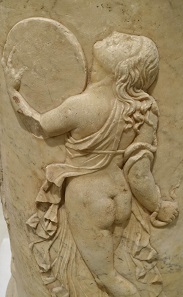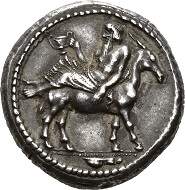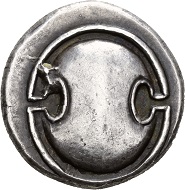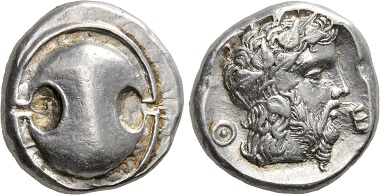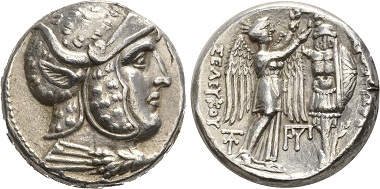Dionysus – The God of Ecstasy
The image depicted on a stater, which was minted in the Thracian city of Abdera between 365 and 361, is quite a spectacular one. Dionysus is riding a panther. Well, he is not so much riding it as he is using the animal as a sort of klinai, i.e. a bed one sprawled out on while indulging in careless carousal.
Abdera. Stater, around 365-361. Extremely fine. Estimate: 125,000,- CHF. From Hess Divo AG Auction 335 (2018), no. 21.
Dionysus’s head is crowned with ivy, he is holding the kantharos in his right hand, in his left hand we see the thyrsus, a staff of giant fennel covered in ivy and vine leaves topped with a pine cone. These symbols – kantharos, vine leaves, thyrsus – all serve to characterize Dionysus as the god of wine, rapture (including the sexual kind), frenzy or – as it was referred to in ancient times – ecstasy. But how is it possible that a god with attributes like these was depicted on a coin and became a symbol of identification within the well-ordered cosmos of a city?
If we really ask ourselves such a question, there is no doubt we have fallen for a 19th century idea. It was Friedrich Nietzsche who turned Dionysus into the great opponent and antipode of the much more cheerful Apollo of the Greek polis. “Noble simplicity and quiet grandeur”, a golden cut, classic and classicism – all of these attributes had characterized ancient Greece in the eyes of the occident in the name of Apollo. However, according to Nietzsche, the natural and the ecstatic – the very thing Freud would later denote “It” – were also rooted in Greek antiquity. He connected it to Dionysus and juxtaposed him in opposition to the Apollon principle of harmony. Human beings had to position themselves in between these two poles. Only within this conflict and interaction was culture possible in the first place.
We can easily understand this reasoning. After all, Nietzsche had been working as an associate professor for classical philology at the University of Basel since 1869. He knew what he was talking about even though his works exceeded the boundaries of philology by far and he redefined Dionysus from his contemporary point of view. Let us therefore turn to how the Greeks saw Dionysus.
Naxos. Tetradrachm, around 461-460. Extremely fine. Estimate: 100,000,- CHF. Price realized: 145,000,- CHF. From Hess Divo AG Auction 329 (2015), no. 20.
Let’s set the record straight. Contrary to the convictions of religious studies scholars up until the 20th century, Dionysus is not a “foreign” god for the Greeks. With the deciphering of Mycenaean script, we discovered that those who constructed the Cyclopean fortresses of Greece were already aware of him. However, a lot of the myths about him point out that some rulers were not showing him respect. Consequently, Dionysus turns into a god who has to make great efforts in order for his divine nature to be acknowledged and for him to be worshipped within the realms of the polis.
Thasos. Stater, around 540-525. Extremely fine. Estimate: 7,500,- CHF. From Hess Divo AG Auction 335 (2018), no. 25.)
This comes as no surprise seeing as Dionysus’s parties would still bring the police to the scene today. Along with excessive drinking, rambunctious celebrations during the night – yes, the word “orgy” did in fact develop in this context – were also part of the ritual. Equipped with the thyrsus, wineskins, and pitchers, followers headed out to nature so as to open up to their god in rapture and to become one with him in some mystical way. In the context of such a sexually charged atmosphere, there surely occurred moments between maenads and satyrs that were more than just platonic: Euripides notes in his play “Ion” that its young hero was an illegitimate progeny stemming from a bacchanalian encounter. Similarly, he ensures us in his “Bacchae” that no respectable woman would ever give in to licentiousness during the rituals of Dionysus.
Dancing Maenads. Relief from the theater of Italica / Spain, Augustan age. Archaeological Museum of Seville. Photo: KW.
At any rate, the king of the Thracian Edoni, Lycurgus, was disgusted by what was happening in the name of a god. He is said to have driven off Dionysus and all of his female followers using a bull’s pizzle (Aeschylus even insinuated the king had favored beer over wine! Shocking!)
Another written record notes that Lycurgus had raped his own mother in a Dionysian frenzy. Allegedly, he was then repulsed by this cult to such an extent that he chased Dionysus out of his kingdom.
Mende. Tetradrachm, around 450-425. Extremely fine. Estimate: 50,000,- CHF. From Hess Divo AG Auction 335 (2018), no. 29.
Whatever the case may be, Dionysus punished Lycurgus with insanity. He is said to have mistaken his son for an ivy stem. Ivy chokes precious trees. Therefore, Lycurgus felt the urge to get rid of said ivy. But the blows of his axe hit his son’s nose, ears, fingers, and toes until he bled to death. The god’s curse affected the entire kingdom of Thracia. Nothing sprouted nor grew until Lycurgus was adequately punished – whether he died from being quartered by man-eating horses, ripped apart by panthers, or caged in stone remains a dispute among writers.
Thebes. Stater of Epaminondas, before 362. Extremely fine. Estimate: 7,500,- CHF. From Hess Divo AG Auction 335 (2018), no. 37.
Thebes, too, had a distinctive connection to Dionysus. Not for nothing, the amphora is one of the most important images on the coins of Thebes and Orchomenus: King Minyas of Orchomenus – which was a member of the Boeotian League just like Thebes – had three daughters who refused to worship Dionysus. Dionysus punished them. Suddenly, milk and nectar were oozing out of their weaving loom and Dionysus appeared in the shape of a bull, lion, and leopard. He scared the girls so much they immediately joined the maenads and the oldest sister – dear me! – slaughtered and ate her own son.
Thebes. Stater, around 440-380. Extremely fine. Estimate: 1,000,- CHF. Price realized: 2,400,- CHF. From Hess Divo AG Auction 332 (2017), no. 37.
Evidently, Dionysus is neither a nice nor a friendly god. He is a god of the most violent extremes that match the ruthless ways of nature. As part of his rituals, animals such as he-goats, deer, or even bulls were ripped apart with bare hands and their raw meat was devoured thereafter. Although its execution is much more brutal, the idea behind it is in fact reminiscent of the Christian communion.
Ainos. Tetradrachm, around 400-370. Extremely fine. Estimate: 50,000,- CHF. From Hess Divo AG Auction 35 (2018), no. 23.
The sacrificial animal – on this coin from Ainos you can see a billy goat standing in front of a wine amphora which is crowned with an ivy wreath – symbolizes the god itself who died and was resurrected for the sake of his followers. We know about this myth due to a written record from the 5th century AD when the animal had long since been replaced by ivy leaves, which the mystes of Dionysus tore up and chewed on. The same source also tells us that Dionysus was a child of Zeus and Semele. His father loved him so ardently, he was even allowed to sit on his throne and swing his bolt. Needless to say, Hera was jealous. She sent out the Titans who went on to distract Dionysus with a mirror. The moment he looked into it, they killed him. They tore him into pieces, cooked him, and ate him. When Zeus received the news he threw his bolt at the Titans. And the mother of gods, Rhea, brought the young Dionysus back to life.
Naxos (Cyclades). Stater, 520-490. Nearly extremely fine. Estimate: 6,500,- CHF. Price realized: 8,500,- CHF. From Hess Divo AG Auction 321 (2012), no. 130.
This record is the basis of all Dionysus mysteries. You see, Dionysus was not just a god of official, urban cults. A secret religion was also dedicated to him, one that was probably even more important than the Demeter mysteries of Eleusis. While the latter were inextricably linked to Eleusis, the Dionysus mysteries could be found in all those places where a wandering priest had founded them. These mysteries promised an eternal life to all followers. The mystes of Dionysus imaged life after death as a sort of eternal wedding procession in which they would follow Dionysus, the groom, in ecstatic jollity. To prove that a deceased person believed in Dionysus, a mirror was put in their grave. A mirror just like the one the young Dionysus had held in his hand before he was mauled by the Titans.
Derveni Krater. The mixing jar that was discovered in Grave B of Derveni. It is likely to indicate that the buried person was a follower of Dionysos. Archaeological Museum of Thessaloniki. Photo: KW.
The countless images of the Dionysus cult we can discover on sarcophagi, jars, and other items that played an important role as burial objects are also likely to be connected to this.
The Theater of Dionysus in Athens. Photo: BishkekRocks.
Hence, Dionysus might have been a disputed, but a very important god in the Greek world and one that many states dedicated their own cult to. As did Athens, of course. Even though Dionysus does not appear on classic coins, several celebrations were held in his honor: the Anthesteria, a type of spring festival initiating the season of seafaring, the Lenaia, which centered around the pressing of wine, and the Oreibasia, which saw the women of Athens walking up into the mountains in order to wake the sleeping Dionysus.
The Dionysia are particularly important for us. They gave us the most beautiful stories Greek literature ever put forth: the plays of Aeschylus, Sophocles, and Euripides, which are being performed up to this day and continue to deeply touch any audience.
The sheer importance of performances at the Theater of Dionysus regarding the Athenians’ sense of community is beyond imagination for us today, seeing as we are constantly flooded by media input. The morals of these plays must have been the subject of discussions all over town. The citizen’s identity, their ideals, and their sense of justice were all influenced by the theatrical performances in the context of the Dionysus cult.
And that was not just the case in Athens. It also happened in other Greek cities who operated their own theaters.
Seleucus I. Tetradrachm, Susa, 305-295. Extremely fine. Estimate: 2,500,- CHF. Price realized: 4,000,- CHF. From Hess Divo AG Auction 328 (2015), no. 65.
Dionysus was a god a civic community as well as rulers were proud to worship. Which is why ancient kings and politicians liked to refer to themselves as “Neos Dionysos”. Seleucus, for example, represents Alexander the Great with a helmet that is covered in panther’s fur – a panther much like the one Dionysus is riding on our first coin.
Was Dionysus considered the great opponent of Apollon in ancient times already? Perhaps this is too idealistic an image of the Delphic god of truth and prophecy. After all, Apollo did shoot Python in order to take over Delphi, he defeated the Greek troops before they could take over Troy by sending the pestilence, and he killed Niobe’s children in a vindictive frenzy. His behavior does not necessarily bespeak of a fundamental contrast between him and Dionysus.
There might not be a stark contrast, but there surely is a subtext: the myths of Dionysus teach us that ecstasy, the euphoric celebration of life, sexuality, and procreation are part of anyone’s existence. You have to find the time and space for all of these things in order to fully enjoy all of what life as a human has to offer.
More information on the 335th Hess Divo AG Auction is available on the auction house’s website.
CoinsWeekly has published a short analysis of why Greek religion is considered a “religion of experiences”.
In 2013, Saturday Night Life poked fun at the Greek debt crisis in a skit including the gods of Greek mythology – including a slightly tipsy Dionysus.













